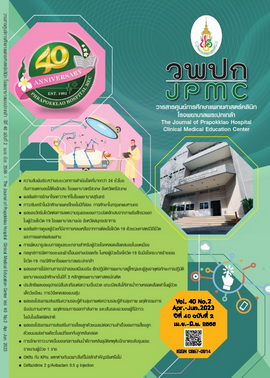OKRs and KPIs: Are They Fundamentally Different in All Unimportant Respects?
Main Article Content
Abstract
This research article carried out documentary research in order to analyze and synthesize data from various academic resources concerning two evaluation techniques, including Objective and Key Results (OKRs) and Key Performance Indicators (KPIs), to answer the question of whether the techniques were fundamentally different in all Unimportant respects. The findings indicated that OKRs and KPIs had many similar aspects in terms of providing importance to targets and results in answering mission/objectives whether at the organizational, work group or individual level. However, OKRs were revealed to be different from KPIs with regard to form, measurement frequency, participation in setting goals, etc. In conclusion, the research determined that OKRs are distinctive in some important respects in the sense that they are used in the implementation phase and act as lead measurements to drive the performance of the KPIs, which are considered lag measures. Therefore, OKRs act as tools to drive the performance of an organization to a higher level. Integrating both techniques to drive organizational performance would help an organization to achieve targets even more effectively.
Article Details

This work is licensed under a Creative Commons Attribution-NonCommercial-NoDerivatives 4.0 International License.
References
Drucker PF. The practice of management. New York: Harper & Row; 1954.
Kudernatsch D. Toolbox objectives and key results: transparent and agile strategy execution with OKR. 2nd ed. Munich: Kudernatsch Consulting & Solutions; 2020
Doerr J. Measure what matters: OKRs: the simple idea that drives 10x growth. New York: Penguin Random House; 2018.
Osborne D, Gaebler T. Reinventing government: how the entrepreneurial spirit is transforming the public sector. New York: Plume; 1993.
Jirawaswong K. Performance management toward excellence with OKRs. 3rd ed. Bangkok: Great Media Agency; 2019.
Wongthongdee S, Petcharaks N, Navanuch P, Tantrajin P, Jaruniphakul N. Perspectives towards talent competencies assessments. J Phrapokklo Hosp Clin Med Educat Center 2022; 39:367-74.
Lobacher P, Jacob C. Objectives & key results (OKR): the agile operating system for modern organizations. Munich: Die.agilen; 2020.
Parmenter D. Key performance indicators (KPI): developing, implementing, and using winning KPIs. 2nd ed. New Jersey: John Wiley & Sons; 2010.
Celen S. OKR: master the performance framework that google perfected: create & achieve your top startup and personal goals using the leading innovation management system. Michigan: Independently published; 2021.
Marr B. 25 need-to-know key performance indicators. Harlow: Pearson Education; 2014.
Grove AS. High output management. New York: Random house; 1983.
Niven PR, Lamorte B. Objectives and key results: driving focus, alignment, and engagement with OKRs. New Jersey: John Wiley & Sons; 2016.
Wodtke CR. Radical focus: achieving your most important goals with objectives and key results. California: Cucina Media LLC; 2021.
Tight M. Documentary research in the social sciences. California: SAGE Publications; 2019.
Bloomberg LD, Volpe M. Completing your qualitative dissertation: a road map from beginning to end. 3rd ed. Los Angeles: SAGE; 2016.
Vellore V. OKRs for all: making objectives and key results work for your entire organization. New Jersey: John Wiley & Sons; 2023.
Marukpitak A. Measurement in the form of Lag Measure and Lead Measure.(Internet) 2019. (cited 2023 Jan 9). Available from: https://anontawong.com/2019/08/07/lead-measure/
Stillman R. Public administration concepts and cases: concepts and cases. 6thed. Boston: Houghton Mifflin College Div; 1996.

